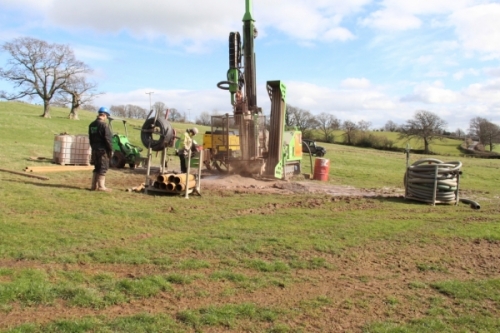Traditional heat pump ground arrays are what are referred to as closed-loop. They are a series of ground collector pipes buried either horizontally in trenches, or inserted into vertical boreholes up to 250m deep with multiple trenches or boreholes being required dependant on the heating load. A glycol/water mix is then circulated through the pipework which acts as a thermal transfer medium absorbing heat from the aquifers (in the case of boreholes) and bringing it to the heat pump refrigerant where it is used in the generation of heat spatial heating, hot water, cooling or other uses.
There is however, another way of extracting heat from the ground and that is by accessing the aquifer’s water directly and extracting heat from that. This is usually done with two boreholes. One abstraction borehole with a pump at the bottom to lift the water to the surface for the heat pump to use and another borehole some distance away to re-inject the water back into the aquifer. Hence open-loop.
As using an open-loop system negates the need for the glycol/water solution and hundreds of meters of 40mm collector array pipe, it is often quoted as being cheaper to install. There are of course good reasons why we will not normally specify an open-loop system, the main one being hidden costs.
The hidden costs of an open-loop system come from the need to regularly clean the heat exchanger, run and service the abstraction pump and obtaining and maintaining a water abstraction licence from the Environment Agency, the cost of which varies by region across the UK.
Another consideration should be the cost of pumping water from the bottom of a borehole to the surface. A recent example for a modest domestic dwelling showed that a 30kW heat pump system would require about 13,000m3 of water each year to be pumped from the bottom of the borehole to the heat pump at ground level. At the abstraction cost of £0.02751p per m3 this equates to around £360 each year. A cost not required for a closed-loop system.
The running costs of an abstraction pump are much higher than those of a closed-loop system’s circulation pump. A closed-loop system requires a much smaller pump due to the balance of pressure in the loop, rather than having to lift vast volumes of water from a great depth. Based on a 2,200 run-hour cycle per year, an open-loop pump would cost about £ 860 in electricity as opposed to the £60 a year running cost of a closed-loop pump.
Finally, there is the maintenance of the system overall. For an open-loop system, the costs of maintaining the abstraction pump, cleaning the heat exchanger and filters for a 30kW system would be about £900 each year. This is compared to the £400 maintenance costs of a closed-loop system.
Taking the above into account, you can see that an open-loop system will require considerable on-going running costs. The closed-loop system having a cost of £460 each year vs the open-loop cost of £2,120 a year.
If you are considering an open-loop heat pump system we strongly advise caution. Make sure the running costs and ongoing maintenance regime will fit with your budget and are realistically accounted for in the quotation. If you would like to discuss alternative ways of collecting heat for a ground source heat pump, please contact us today or call us on 01293 821 345.







